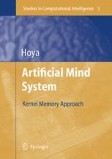Search
Search Results
-
The Kernel Memory Concept – A Paradigm Shift from Conventional Connectionism
In this chapter, the general concept of kernel memory (KM) is described, which is given as the basis for not only representing the general notion of...
-
Modelling Abstract Notions Relevant to the Mind and the Associated Modules
This chapter is devoted to the remaining four modules within the AMS, i.e. 1) attention, 2) emotion, 3) intention, and 4) intuition module, and their...
-
Bioinformatics with Evolutionary Computation
This chapter makes the presumption that it is more important to understand the domain of the problem of interest and to pursue the best achievable...
-
Introduction
Genetic algorithms (GAs) are powerful search techniques based on principles of evolution. They are now widely applied to solve problems in many...
-
Linkage Learning Genetic Algorithm
In order to handle linkage evolution and to tackle the ordering problem, Harik [47] took Holland’s call [53] for the evolution of tight linkage quite...
-
Preliminaries: Assumptions and the Test Problem
After introducing the background and motivation of the linkage learning genetic algorithm, we will start to improve and understand the linkage...
-
Rough Set Theory with Applications to Data Mining
This paper is an introduction to rough set theory with an emphasis on applications to data mining. First, consistent data are discussed, including...
-
From Classical Connectionist Models to Probabilistic/Generalised Regression Neural Networks (PNNs/GRNNs)
This chapter begins by briefly summarising some of the well-known classical connectionist/artificial neural network models such as multi-layered...
-
Language and Thinking Modules
In this chapter, we focus upon the two modules which are closely tied to the concept of “action planning”, i.e. the 1) language and 2) thinking...
-
Sensation and Perception Modules
In any kind of creature, both the mechanisms of sensation and perception are indispensable for continuous living, e.g. to find edible plants/fruits...
-
Reinforcement Learning: A Brief Overview
Learning techniques can be usefully grouped by the type of feedback that is available to the learner. A commonly drawn distinction is that between...
-
An Analysis of Continuous-Valued Representations for Learning Classifier Systems
Learning Classifier Systems [11] typically use a ternary representation to encode the environmental condition that a classifier matches. However,...
-
Data Driven Fuzzy Modelling with Neural Networks
Extraction of models for complex systems from numerical data of behavior is studied. In particular, systems representable as sets of fuzzy if-then...
-
Content Based Image Compression in Biomedical High-Throughput Screening Using Artificial Neural Networks
Biomedical High-Throughput Screening (HTS) requires specific properties of image compression. Particularly especially when archiving a huge number of...
-
Discriminative Clustering of Yeast Stress Response
When a yeast cell is challenged by a rapid change in the conditions, be it temperature, osmolarity, pH, nutrient or other, it starts a genome stress...
-
Medical Bioinformatics: Detecting Molecular Diseases with Case-Based Reasoning
Based on the Human Genome Project, the new interdisciplinary subject of bioinformatics has become an important research topic during the last decade....
-
Systems biology of apoptosis
New approaches are required for the mathematical modelling and system identification of complex signal transduction networks, which are characterized...
-
Scientific and technical challenges for systems biology
Systems biology is an emergent discipline, yet can be rooted back almost a century when pioneering thoughts on system-oriented views were discussed....
-
Systems Biology: necessary developments and trends
At the end of this definition of Systems Biology through exampling, we discuss ambitions, goals, and challenges relating to this new discipline. We...
-
From isolation to integration, a systems biology approach for building the Silicon Cell
In the last decade, the field now commonly referred to as systems biology has developed rapidly. With the sequencing of whole genomes and the...
